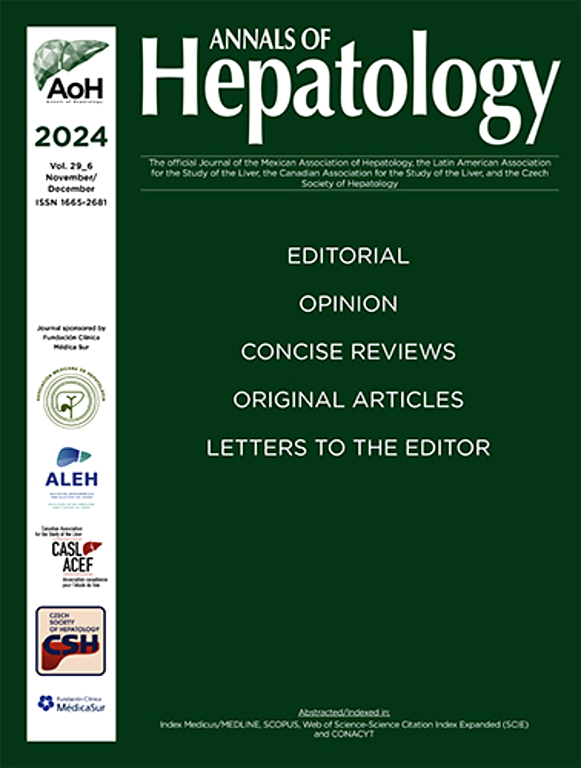Utility of the CLIF-C AD score to assess readmission in patients with acute decompensation of non-ACLF cirrhosis.
IF 4.4
3区 医学
Q2 GASTROENTEROLOGY & HEPATOLOGY
引用次数: 0
Abstract
Introduction and Objectives
Patients with cirrhosis who require hospitalization due to acute decompensation (ascites, digestive bleeding, hepatic encephalopathy, among others), have a variable adverse prognosis, depending on whether they have acute-on-chronic liver failure (ACLF), the CLIF-C AD test allows to identify the risk of readmission, development of ACLF and mortality.
Materials and Patients
A cross-sectional study was carried out between October 2023 and May 2024. The CLIF-C AD test was calculated in patients with decompensated cirrhosis. The results were analyzed using descriptive statistics, frequency analysis, and percentages. Group comparison analysis was performed with Student's T and chi square as appropriate, to determine the sensitivity and specificity of this test, and a ROC curve was performed; Likewise, Kaplan Meyer curves of 2 groups were used according to the CLIF-C AD categorized as 62 or less and greater than 62; having a significant value of p:0.005; The analysis was performed with the statistical program SPSS version 25.
Results
There were 40 patients; 32 men and 8 women. Cirrhosis etiology: alcohol 30 patients (75%), MASLD 8 patients (20%), autoimmune hepatitis 2 patients (5%). Cause of decompensation: Upper digestive bleeding in 19 patients (47.5%), urinary infection in 8 patients (20%), tense ascites in 4 patients (10%), spontaneous bacterial peritonitis in 3 patients (7.5%). Findings on admission: ascites 27 patients (67.5%), hepatic encephalopathy 27 patients (67.5%), shock 18 patients (45%). The CLIF-C-AD score with a median of 68 IQR (52-73). Readmission 35 patients (87.5%); The cause of readmission was hepatic encephalopathy in 17 patients (42.5%), upper digestive bleeding in 10 patients (25%), and acute kidney injury in 3 patients (7.5%). Using Student's T, the CLIF-C AD score is determined for those who were readmitted with a mean of 66 and for those who were not readmitted with a mean of 41 (p<0.001). In the ROC curve, the area under the curve was found to be 0.950 with 95% CI (0.890-1.000) p=0.001, sensitivity 77%, specificity 100%, with a Youden point of 62 points; Therefore, it is categorized into 2 groups based on this score for a cumulative incidence of readmission by Kaplan Meier curve, showing a difference between the groups with a Log Rang test of 0.005.
Conclusions
The CLIF-C AD score is a practical, adequate, and useful tool to determine the outcome of decompensated cirrhotic patients, which will allow the identification of high-risk patients and the implementation of close follow-up strategies and timely therapeutic adjustment and avoid adverse outcomes. More studies are required and increased sample size.
CLIF-C AD评分评估非aclf肝硬化急性失代偿患者再入院的应用
由于急性失代偿(腹水、消化性出血、肝性脑病等)需要住院治疗的肝硬化患者,根据他们是否患有急性慢性肝衰竭(ACLF),有不同的不良预后,clifc - AD测试可以识别再入院、ACLF发展和死亡率的风险。材料与患者横断面研究于2023年10月至2024年5月进行。在失代偿性肝硬化患者中计算clifc - AD测试。使用描述性统计、频率分析和百分比分析结果。酌情采用Student’s T和卡方进行组间比较分析,确定该试验的敏感性和特异性,并绘制ROC曲线;同样,两组的Kaplan Meyer曲线根据CLIF-C AD分为62或小于和大于62;显著值p:0.005;采用SPSS version 25统计软件进行分析。结果共40例患者;32男8女。肝硬化病因:酒精30例(75%),MASLD 8例(20%),自身免疫性肝炎2例(5%)。失代偿原因:上消化道出血19例(47.5%),泌尿系感染8例(20%),紧张性腹水4例(10%),自发性细菌性腹膜炎3例(7.5%)。入院时发现:腹水27例(67.5%),肝性脑病27例(67.5%),休克18例(45%)。cliff - c - ad评分中位数为68 IQR(52-73)。再入院35例(87.5%);再入院原因为肝性脑病17例(42.5%),上消化道出血10例(25%),急性肾损伤3例(7.5%)。使用Student's T,再入院患者的平均分数为66分,未再入院患者的平均分数为41分(p<0.001)。在ROC曲线上,曲线下面积为0.950,95% CI (0.890-1.000) p=0.001,敏感性77%,特异性100%,约登点为62点;因此,根据Kaplan Meier曲线将该评分的累计再入院发生率分为2组,Log range检验的组间差异为0.005。CLIF-C AD评分是确定失代偿期肝硬化患者预后的一种实用、充分和有用的工具,可以识别高危患者,实施密切随访策略,及时调整治疗,避免不良后果。需要更多的研究和增加样本量。
本文章由计算机程序翻译,如有差异,请以英文原文为准。
求助全文
约1分钟内获得全文
求助全文
来源期刊

Annals of hepatology
医学-胃肠肝病学
CiteScore
7.90
自引率
2.60%
发文量
183
审稿时长
4-8 weeks
期刊介绍:
Annals of Hepatology publishes original research on the biology and diseases of the liver in both humans and experimental models. Contributions may be submitted as regular articles. The journal also publishes concise reviews of both basic and clinical topics.
 求助内容:
求助内容: 应助结果提醒方式:
应助结果提醒方式:


